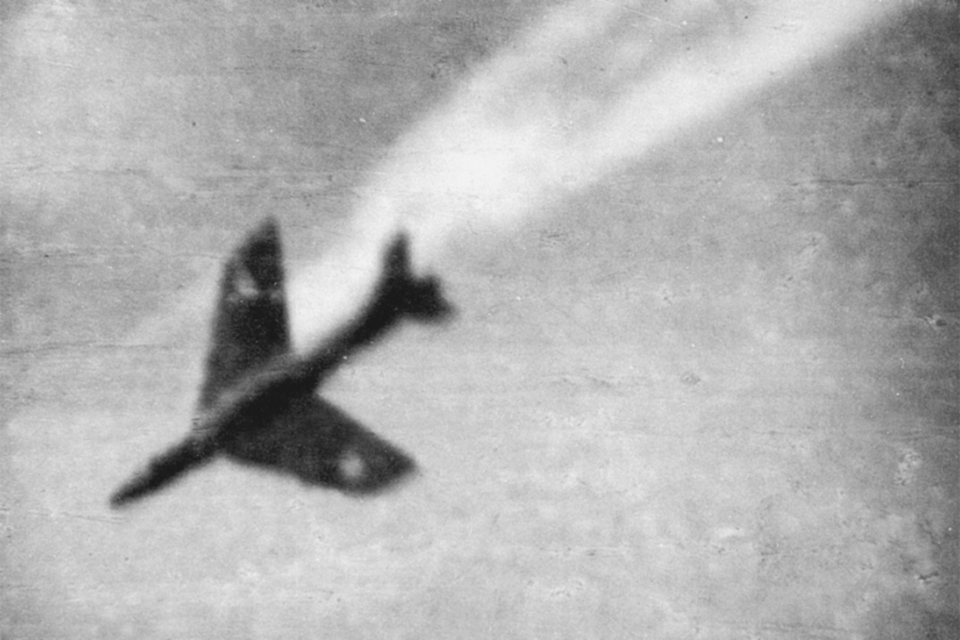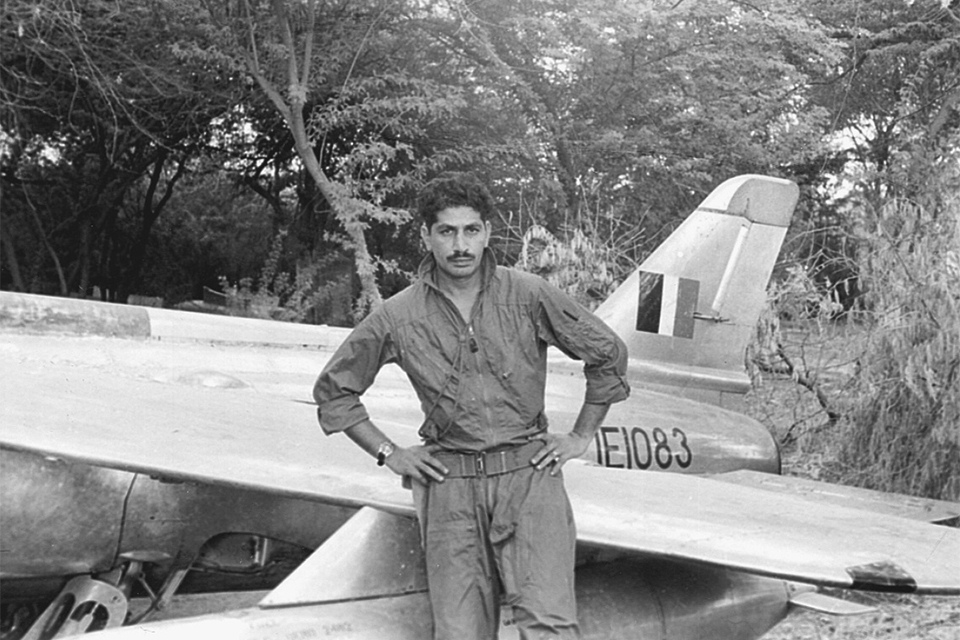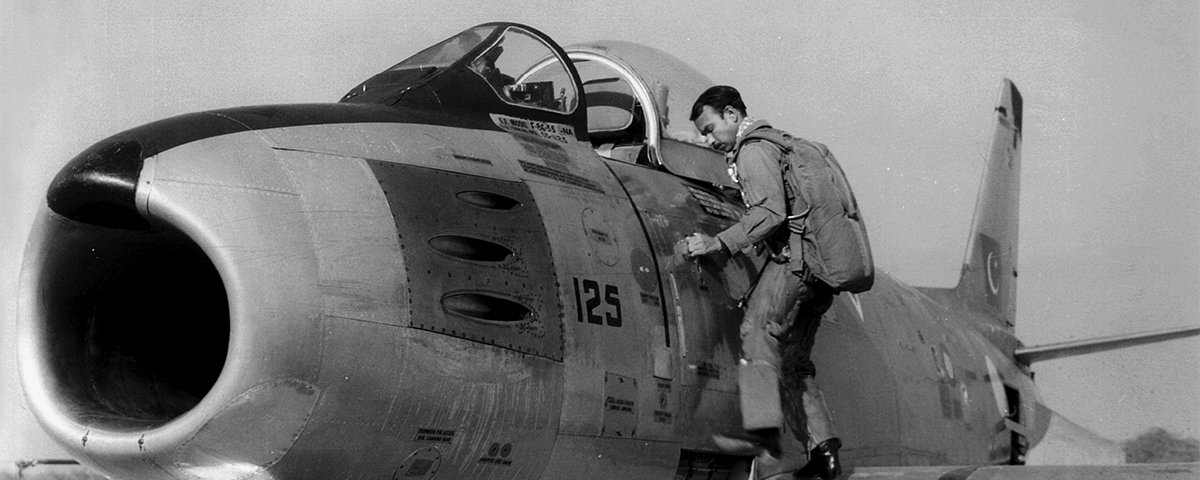All over the world, fighter pilots are the same. They won’t stand for enemy aircraft attacking their nest. In early September 1965, Squadron Leader Muhammad Alam of the Pakistan Air Force dived his North American F-86F Sabre after seven Indian Air Force Hawker F.56 Hunter fighter-bombers raiding Sargodha, a Pakistani air base 80 miles west of the Indian border.
“I took the last man and dived behind him, getting very low in the process,” recounted Alam. He had flown the Hunter in Britain, and knew that it “can out-run the Sabre—it’s only about 50 knots faster, but has a much better acceleration, so it can pull away very rapidly.” But Alam had 1,400 hours in the F-86, some of the highest gunnery scores in the PAF and a pair of heat-seeking missiles under his wings. “Since I was diving, I was going still faster, and as he was out of gun range, I fired the first of my two GAR-8 Sidewinder missiles at him. In this case, we were too low and I saw the missile hit the ground short of its target.”
As the Indian formation broke up, Alam fired his second missile. “I didn’t see it strike,” he said. “The next thing I remember was that I was overshooting one of the Hunters and when I looked behind, the cockpit canopy was missing and there was no pilot in the aircraft.” He went after the rest. “When I was in gunfire range they all saw me. They all broke in one direction, climbing and turning steeply to the left, which put them in loose line astern. This, of course, was their big mistake.”
The next 30 seconds have passed into PAF legend. “It all happened very fast,” Alam admitted. “We were all turning very tightly—in excess of 5g or just about on the limits of the Sabre’s very accurate A-4 radar-ranging gunsight. And I think before we had completed about 270 degrees of the turn, at around 12 degrees per second, all four Hunters had been shot down.”

To this day, both sides in the 1965 Indo-Pakistani War deny most of each other’s claims, yet the conflict provided a unique test of Western weapons in combat. Pakistan fought with American-made tanks and airplanes. Though flirting with the Soviets, India bought the bulk of its armor and aircraft in Europe. Both air forces were organized in the British colonial tradition. But ever since their mutual independence in 1947, Pakistan considered the northern Indian territory of Kashmir to be on the wrong side of the border. In August it invaded, and on September 1 Indian army units called in air support. The PAF was outnumbered 5-to-1.
The IAF’s twin-boom de Havilland Vampire jets had first flown during World War II. A dozen sent to strafe Pakistani tanks on September 1 proved easy meat for PAF Sabres, which in the conflict’s first dogfight scored three victories for no losses. With war having not yet been declared, Sabre pilot Sqd. Ldr. Sarfaraz Rafiqui scored two before querying his radar ground controller, “Did you mean us to shoot to kill or to frighten?”
“To kill,” was the answer, “and you’ve done it.”
The next day, however, the Indians moved a flight of little Folland F.1 Gnat fighters up to the front. “We want you to shoot down Sabres,” their pilots were briefed. “How you do it is your problem, but the Sabres have to be tackled.”
On the morning of September 3, PAF Sabres scrambled to meet four IAF Dassault MD.454 Mystère IVa fighter-bombers. The Mystères, mere bait, fled. Four Gnats rose in their place. PAF Sqd. Ldr. Yusuf Ali Khan banked his F-86F into the middle of their formation. “Just as I was about to launch my GAR-8,” he said, “I felt a series of thuds on my aircraft.”
IAF Sqd. Ldr. Trevor Keelor closed to 200 yards, firing his Gnat’s twin 30mm cannons. Seeing an explosion on the Sabre’s right wing and the aircraft plunge away, he would claim the IAF’s first air-to-air kill. The PAF reported a cannon shell hit one of Khan’s Sidewinders, causing the explosion, but he managed to return to Sargodha. One Gnat was lost when Sqd. Ldr. Brijpal Singh Sikand, low on fuel and lost, landed on a PAF airfield. The Pakistanis claimed he surrendered to a Lockheed F-104 Starfighter flown by Flt. Lt. Hakimullah Khan Durrani; at any rate, Sikand’s Gnat is on display to this day at the PAF museum in Karachi. Much to the derision of the Pakistanis, the Indians nicknamed the Gnat the “Sabre Slayer.”

On the 4th, PAF Flt. Lt. Aftab Alam Khan dived his Starfighter through four Indian Mystères that were strafing a passenger train. As they scattered low over the deck, he swung back around on their tails to fire a Sidewinder. “The flash of the missile blinded me for a few seconds,” Khan recalled. “The radar controller, who was also monitoring the radio of the Mystères, immediately informed me that one Mystère had been shot down and that another had been damaged….It was also the first combat kill by any Mach 2 aircraft and the first missile kill for the Pakistan Air Force.” India claimed their aircraft had merely dropped its external fuel tanks, which exploded on impact.
Meanwhile, flying at low level to attack the Indian base at Adampur, Alam’s three-Sabre flight spotted four IAF No. 7 Squadron Hunters crossing their path about 500 feet off the ground. “I never fought at such low altitudes again,” Alam said, “nor often at such low speeds.” The seven jets got into a turning battle, down to 200 knots and treetop level. “In maneuverability, the Sabre was undoubtedly better than the Hunter,” Alam noted. He saw his first target flick over into the ground, “although I’m not certain whether I hit him or not.” IAF Sqd. Ldr. A.K. “Peter” Rawlley was killed. Alam claimed a second Hunter as well, which the Indians did not concede.
Elsewhere, three Sabres led by Sqd. Ldr. Rafiqui jumped two Hunters covering the IAF base at Halwara. Rafiqui shot down the leader, but four more Hunters arrived, two from each side. “My guns have stopped firing,” Rafiqui reported. In a confused ground-level dogfight, the Pakistanis claimed four Hunters, but two Sabres were shot down, including Rafiqui, who ejected too low and was found near his wrecked aircraft. He was posthumously awarded the Crescent of Courage, Pakistan’s second-highest military award.
On September 7, probably the critical day of the air war, the IAF was determined to take the fight to Pakistan. A dawn raid by Mystères took Sargodha by surprise. As the Indians scattered homeward, Flt. Lt. Amjad Hussain Khan pursued two of them in his F-104A. He returned to base later that day via bicycle, horse and helicopter, reporting that he’d shot down both Mystères, the second so close that his Starfighter ingested exploded debris, forcing him to eject. The Indians claimed that Khan fired on the same target twice: Sqd. Ldr. Ajjamada B. Devayya, who heroically shot down the Starfighter before succumbing himself. But witnesses from a Pakistani village told a third version: “…two aircraft approached from the direction of Sargodha and got into a turning fight for several minutes. Then the rear aircraft [the Starfighter] started firing its cannon; it was, however, so fast that it collided with the front one.” Both pilots won medals, Devayya posthumously.
A subsequent wave of IAF Hunters was scattered in Alam’s legendary attack. Asked by his ground controller what he was counting, Alam answered, “Don’t you see, I’ve just shot down five Hunters.” His victories, confirmed by his wingman and several other PAF pilots on the scene, are vigorously denied by the Indians, though two Hunters crashed in Pakistani territory. Alam’s kills brought his score to seven, making him the war’s leading ace.
That day both sides took the air war to another level, opening a new front with East Pakistan (modern Bangladesh). From Kalaikunda, a former WWII bomber base west of Calcutta, the IAF launched a dawn raid by two English Electric Canberra bombers, across the Bay of Bengal, against a PAF Sabre base at Chittagong. Wing Commander Peter Wilson’s 1940s-vintage 1,000-pound bombs failed to explode, which hardly mattered, as there were no Sabres on base. On their return approach the Canberras were intercepted by Indian Hunters, whose pilots only at the last second recognized their side-by-side cockpits; crews of Pakistan’s American-made Martin B-57 Canberras sat in tandem.
Chittagong’s Sabres had actually taken off from Tejgaon to attack Kalaikunda. The two Canberras, refueled and being rearmed, were destroyed where they sat, along with four Vampires. All the Sabres returned home unscathed. Wilson’s report summed up the morning’s action: “FIASCO!”
The PAF, however, erred in launching a follow-up strike. IAF Flt. Lt. Alfred Cooke and his wingman, waiting in their Hunters, caught four Sabres over the field. Both sides split up, and Cooke got behind the second F-86 pair. He and Flying Officer Afzal Khan, in the trailing Sabre, scissored back and forth at ground level. “I started firing at a range of 600 yards, and I could see that he was below tree-line height,” Cooke recalled. “I did not realize that I was that low and that my wing tip was actually hitting the scrub. I stopped firing to get away from the ground and saw his aircraft explode into a ball of flame, and I could not avoid flying through the fireball and debris.” Khan was killed.
But meanwhile the lead Sabre had come around on Cooke’s tail. “I took violent evasive manoeuvres,” Cooke said, “and during the criss-cross scissors we would cross very close to each other….I kept on firing and closing in rapidly on him, and I could see pieces of his aircraft disintegrating. I stopped firing, as I was so close (100 yards) that if I did not break away I would collide with him.” Flight Lieutenant Tariq Habib Khan escaped back to base, but his Sabre was written off.
“On recovering from this I immediately pulled upward to the right and saw another Sabre behind me,” reported Cooke. “I out-manoeuvred him and got behind as he pulled up in a vertical climb and then winged over to go into a vertical dive with me following and firing at him all the time. In the vertical dive I kept firing at him as he pulled out of the dive….I pulled back on the joystick with my finger on the trigger and got out of the dive with guns still firing until I had expended my ammunition.”
Cooke spotted the remaining Sabre closing on his wingman, and attacked. “This guy tried to shake me off by doing loops and barrel rolls right over the airfield. I got behind him to firing range and tried to take a shot but there was no ammo….It was at this stage that I noticed grey puffs of smoke appearing in front of me and all around me and I realised that the AA was firing at me as well.” He chased the Sabre back across the border and, on finally landing, flamed out for lack of fuel several hundred yards short of his parking area, his port wing trailing foliage and his wingtip pitot tube bent upward from snagging brush. The surviving PAF pilots reported being attacked by nine Hunters.
After the 7th, commemorated thereafter in Pakistan as Air Force Day, both sides dialed back the air war. Their NATO suppliers, disconcerted to see client states using their weaponry on each other, had curtailed delivery of replacement aircraft and parts. Fighter pilots turned to ground-attack missions. PAF B-57s flew so many night nuisance raids that Indian base personnel collectively called them “8-Pass Charlie,” on the assumption one pilot was making eight separate attacks every night. They had no night fighter capability, but the Pakistanis did.
On the night of September 20-21, four IAF Canberras bombed Sargodha. As they headed for the border, an F-104 rose up in the darkness behind them. Wing Commander Jamal Ahmed Khan tracked his target on radar, closing to within just over a mile before triggering a Sidewinder. “It was pitch black and I had no visual contact with the Canberra until the flash of the missile strike,” he reported. “…It started spiraling down, and then flames started coming out of it when it had got down to about 15,000 ft. I circled round and watched it until it hit the ground. I felt good, but when the Indian pilot was picked up he said he thought the whole business was ‘very unfair.’” It was worse for the Indian navigator/bombardier, who rode the bomber into the ground.
By this time, the United Nations was pressuring both sides to desist. Before hostilities ended, however, Pakistan’s redoubtable Alam and his wingman drew up a pair of Hunters over Indian territory on September 16. He and the IAF leader, Flying Officer Prakash Pingale, went after each other’s wingmen, shot them both down, then turned on each other. “As we crossed head-on, he opened fire on me,” remembered Pingale. The two jets got into a turning battle, the Sabre’s (and Alam’s) forte. Pingale reported, “I attempted to close in but lost contact with Sabre No. 1 because I blacked out due to excessive g (around 8-10 as recorded by my g-meter).”
Alam fired both of his Sidewinders at Pingale, the second of which “hit on his wing root. As it began to smoke, I saw that…I was well inside Indian territory and getting a bit short of fuel.” He opted to break off. Pingale made it home, but Alam was credited with two kills, bringing his total to nine (hotly disputed by the Indians) and making him Pakistan’s ace of aces.
A ceasefire was declared on September 23. Neutral estimates put aircraft losses at 70-odd Indian (about 10 percent of the country’s strength) and 20 Pakistani (seven percent). The venerable F-86, when flown by skilled pilots, proved still capable. The Starfighter, conceived as a high-level interceptor, was less effective as a low-level, slash-and-run dogfighter. The Western military embargo, however, had the effect of turning both countries toward China and the Soviet Union. Their confrontation continues to blow hot and cold, making it one of the world’s longest ongoing crises and arguably among the most likely to go nuclear.
For the Pakistani view of the war, frequent contributor Don Hollway recommends Battle for Pakistan: The Air War of 1965, by John Fricker; for the Indian viewpoint, try India-Pakistan Air War of 1965, by P.V.S. Jagan Mohan and Samir Chopra.
This story was originally published in the May 2017 issue of Aviation History magazine. Subscribe here.

